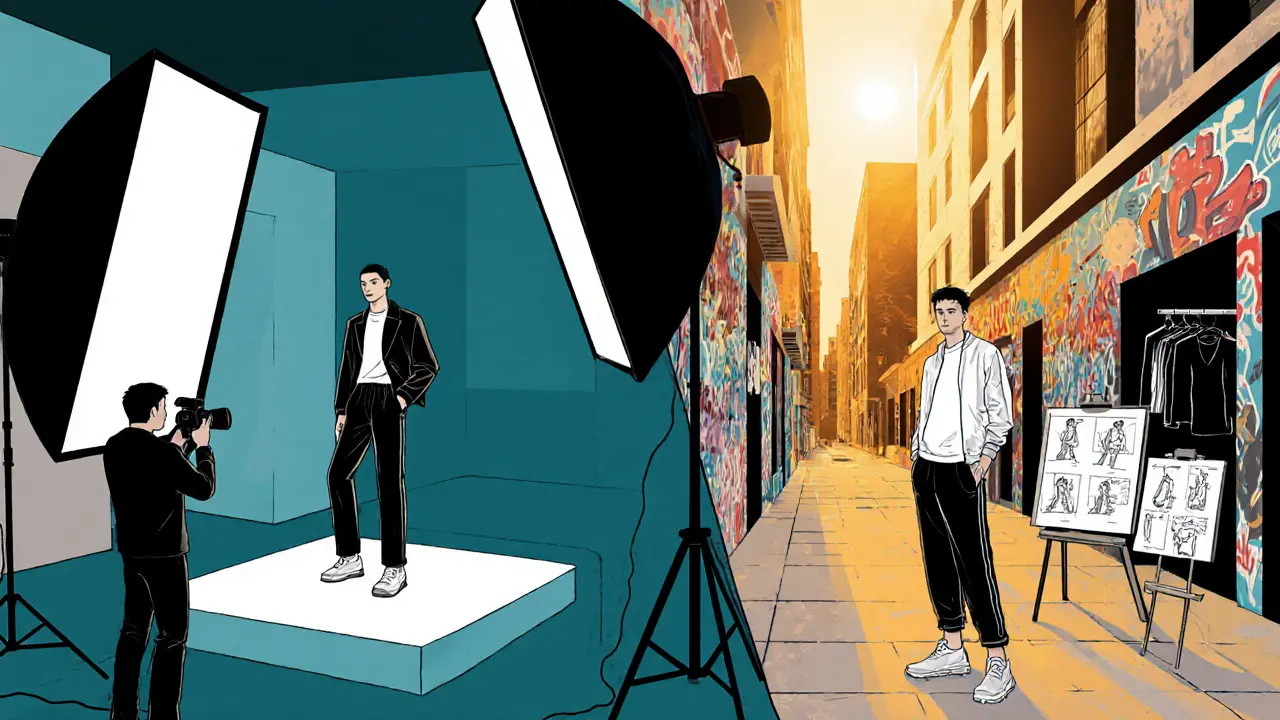Key Takeaways
- Start with a clean headshot and at least three versatile looks.
- Combine a physical comp card with a digital portfolio for maximum reach.
- Use a simple website or a curated Instagram profile to showcase high‑quality images.
- Keep the layout tidy, include contact info, and update every 6‑12 months.
- Avoid over‑editing, too many photos, and missing model measurements.
Direct Answer
A beginner model portfolio typically includes a professional headshot, a few well‑lit full‑body shots that illustrate range, and a compact physical comp card a one‑page card displaying key images and stats. Most newcomers also create a digital version-either a simple website or an Instagram page-so casting directors can view the work online.
Comprehensive Guide to Building Your First Model Portfolio
Imagine you’re walking into a casting call with a sleek card in your hand and a QR code on your phone that links to an online gallery. That’s the confidence boost a well‑planned portfolio provides. Below, we walk through every step, from understanding what a portfolio really is to polishing it for agency submissions.
Definition and Context
Model portfolio a curated collection of photographs that showcases a model’s look, versatility, and measurements is the visual résumé every model carries. For beginners, the goal is to demonstrate potential without overwhelming the viewer. Agencies and casting directors skim through dozens of portfolios daily; a clear, focused presentation is your ticket to getting noticed.

Benefits of a Well‑Structured Portfolio
- Instant credibility - professional images signal you take the work seriously.
- Versatility proof - a mix of styles shows you can adapt to different briefs.
- Easy sharing - a physical comp card for in‑person meetings and a digital link for email submissions.
- Career tracking - regular updates let you see growth over time.
- Agency appeal - most agencies request a compact portfolio before scheduling an interview.
Types of Portfolios Available to Beginners
There isn’t a one‑size‑fits‑all solution. Most newcomers combine two or three formats:
- Physical Comp Card - a printed, pocket‑sized card with a headshot on one side and two or three body shots on the other, plus measurements.
- Digital Portfolio Website - a simple, mobile‑friendly site that hosts a gallery, bio, and contact form.
- Instagram Model Profile - a curated feed that acts as a living portfolio, often linked in agency applications.
How to Build Each Portfolio Component
1. Choose a Photographer
Photographer a professional who understands lighting, posing, and model direction is the cornerstone of any portfolio. Look for someone with experience shooting models, not just weddings or events. A short test shoot (often free or discounted for newbies) can reveal if the style matches your vibe.
2. Capture the Core Shots
- Headshot - clean, minimal makeup, neutral background. This photo appears on the front of your comp card and at the top of digital galleries.
- Full‑body fashion - at least one street‑style look and one studio look. Show you can walk, pose, and move.
- Editorial or themed - a creative shot that hints at your range (e.g., high‑fashion, swimwear, commercial).
3. Create the Physical Comp Card
Use a template from a print shop or an online service. Include:
- Front: your headshot, name, agency (if any), and contact phone/email.
- Back: two to three body shots, height, bust/waist/hips, shoe size, and eye/hair color.
Keep the design simple-bold fonts or busy backgrounds distract from the images.
4. Set Up a Portfolio Website
Platforms like Squarespace, Wix, or WordPress offer free templates tailored for models. Your site should include:
- A homepage with the headshot and a brief tagline (e.g., “Dubai‑based commercial model”).
- A gallery page organized by category (fashion, editorial, lifestyle).
- A bio page with measurements, a short personal story, and agency affiliations.
- A contact page with a simple form and a QR code linking to your Instagram.
Make sure the site loads quickly on mobile; most casting directors view portfolios on their phones.
5. Curate Your Instagram Profile
Instagram can double as a digital portfolio if you keep it tidy:
- Post your best four‑to‑six images in a grid layout.
- Use consistent lighting and a neutral color palette.
- Write concise captions that include your measurements and location.
- Switch to a professional account to access analytics and a contact button.
What to Include and What to Skip
Must‑include:
- Current measurements (height, bust, waist, hips, shoe size).
- Clear contact details (phone, email, or agency manager).
- A mix of looks that shows range (commercial, editorial, runway).
Common pitfalls to avoid:
- Over‑edited photos that hide your natural look.
- More than ten images - casting directors lose focus.
- Including group shots where you’re not the focal point.
- Out‑of‑date measurements - update at least twice a year.

Comparison Table: Physical Comp Card vs. Digital Portfolio
| Aspect | Physical Comp Card | Digital Portfolio |
|---|---|---|
| Portability | Easy to hand out at castings | Accessible via link on any device |
| Cost | Printing fees (≈ $30‑$50 for a batch) | Domain & hosting (~$10‑$15/year) |
| Update Frequency | Requires re‑print for changes | Instantly replace images |
| First‑impression Impact | Tangible, feels professional | Can showcase larger galleries |
| Best For | In‑person auditions, local agencies | International outreach, social media pitches |
Next Steps and Troubleshooting
If you’ve assembled the core images but feel something’s missing, try these quick fixes:
- Missing variety? Schedule a second shoot focusing on a different style (e.g., athleisure vs. formal).
- Measurements outdated? Visit a local tailor or use a reliable measuring app.
- Website not loading fast? Compress images to under 500KB each and enable lazy loading.
- Instagram looks cluttered? Archive older posts and keep the grid to 12‑18 high‑impact images.
Remember, a portfolio is a living document. Treat it like a personal brand-regularly review and refine.
Frequently Asked Questions
How many photos should a beginner model include in a comp card?
Three to four high‑quality shots are ideal: one headshot on the front and two to three full‑body images on the back. Anything beyond that crowds the card and dilutes impact.
Do I need a professional photographer for my first portfolio?
While you can start with a high‑end smartphone, a photographer who knows lighting and posing will give you images that stand out to agencies. It’s a worthwhile early investment.
Can I rely solely on Instagram as my portfolio?
Instagram works well for visibility, but most agencies still request a printable comp card or a direct link to a dedicated website. Use Instagram as a supplement, not a replacement.
How often should I update my portfolio?
Aim for an update every 6‑12 months, or sooner if your look changes dramatically (hair, weight, height).
What should I write in the bio section of my website?
Keep it short: name, location, key measurements, a single sentence about your modeling style, and any agency affiliations. A friendly tone works better than a corporate one.
Take Action Today
Ready to turn those snapshots into a professional model portfolio? Book a shoot, choose a template, and set up a simple site this week. The sooner you have a tangible card and a clickable link, the faster casting directors can see what you offer.







October 12, 2025 AT 17:46
Ah, the age‑old paradox of the aspiring model clutching a comp card like a medieval banner while simultaneously scrolling through Instagram like a digital oracle. One might argue that the very notion of “beginner” is a construct designed by agencies to keep the hopeful in a perpetual state of preparation. The guide’s insistence on a “clean headshot” is, of course, a subtle reminder that the industry values surface over substance, a fact that never ceases to amuse the cynic. Yet, there is a whisper of truth in the recommendation to combine physical and digital portfolios, as if the two realms could somehow reconcile the tactile longing of a casting director with the endless scroll of a talent scout. The suggested three versatile looks are essentially a minimalist’s nightmare, forcing one to condense a personality into a handful of poses. Humorously, the advice to avoid over‑editing is a thinly veiled accusation that natural beauty is somehow scarce. One could spend a decade perfecting a portfolio only to be dismissed because the measurements are out of date, a tragedy of bureaucratic precision. The table comparing comp cards to digital sites reads like a courtroom testimony where each pro‑ and con‑argument is a piece of evidence against the model’s own authenticity. The recommendation to update every six to twelve months is, in reality, a gentle nudge to keep the industry fed on fresh content, lest the model become a relic. The paragraph about photographers reads like a love letter to the gatekeepers of light, urging novices to bow before the person holding the camera. It is almost poetic that the guide tells you to “choose a photographer who understands lighting and posing,” as if lighting is a deity you must worship. The advice to keep your Instagram grid tidy mirrors the ever‑present fear that a stray selfie will ruin a curated brand. Meanwhile, the call to “compress images to under 500KB” sounds like a techno‑paranoia whispering about bandwidth and attention spans. All this culminates in the final rallying cry to “book a shoot this week,” which reads less like encouragement and more like a subtle threat that time is ticking. In sum, the article delivers a masterclass in how to appear both professional and perpetually in‑need of validation, a duality that defines the modern model’s existence.